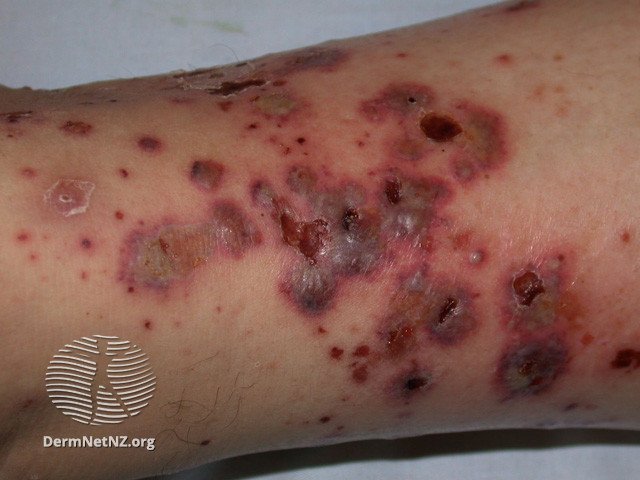
Cutaneous Vasculitis
An example of small-vessel vasculitis, which manifests as palpable purpura in the skin; bruise-like, raised bumps and blisters.
Credit: DermNet NZ
What is cutaneous vasculitis?
Cutaneous vasculitis is a condition characterized by inflammation of the small blood vessels in the skin. This inflammation leads to damage to the affected skin. While vasculitis primarily targets the skin's small vessels, it can occasionally impact vessels in other organs, such as the kidneys, or even larger blood vessels. When vasculitis doesn't affect the skin but involves larger vessels, specialists like rheumatologists typically manage it.
What causes cutaneous vasculitis?
The etiology of cutaneous vasculitis can be diverse, encompassing reactions to medications, infections, hematologic disorders, and autoimmune conditions. Blood tests are usually conducted to ascertain any potential underlying cause. Addressing this root cause can often alleviate the vasculitis symptoms. Nonetheless, about half of the time, there is no trigger identified.
What are the symptoms of cutaneous vasculitis?
For small vessel vasculitis, the skin manifests with multiple purplish, bruise-like patches that can evolve into palpable purpura, or raised bumps. Intense inflammation might lead to blistering in some cases. Pressure points, especially the lower legs, feet, and occasionally the buttocks, are the most frequent sites for these skin changes. When vasculitis impacts other organs, it may manifest as joint pain, abdominal discomfort, or renal disturbances.
How do I treat cutaneous vasculitis?
The treatment strategy hinges on the presence of any underlying causative factors. Addressing these factors is crucial to halt the progression of vasculitis. Several therapeutic approaches can be employed to reduce vascular inflammation and prevent further tissue injury, including:
Oral or Injectable Steroids
Immunosuppressive medications like colchicine, hydroxychloroquine, or methotrexate
Anti-inflammatory agents such as dapsone
Given the predilection of cutaneous vasculitis for gravity-dependent areas like the lower extremities, compression therapy can be beneficial. Generally, skin-limited vasculitis resolves over weeks to months, allowing for the discontinuation of treatment. However, kidney function may need consistent monitoring for a few years even after symptom resolution.
Types of vasculitis tend to affect gravity-dependent areas.
Credit: DermNet NZ
In severe cases, vasculitis may cause ulcers on the skin.
Credit: DermNet NZ



